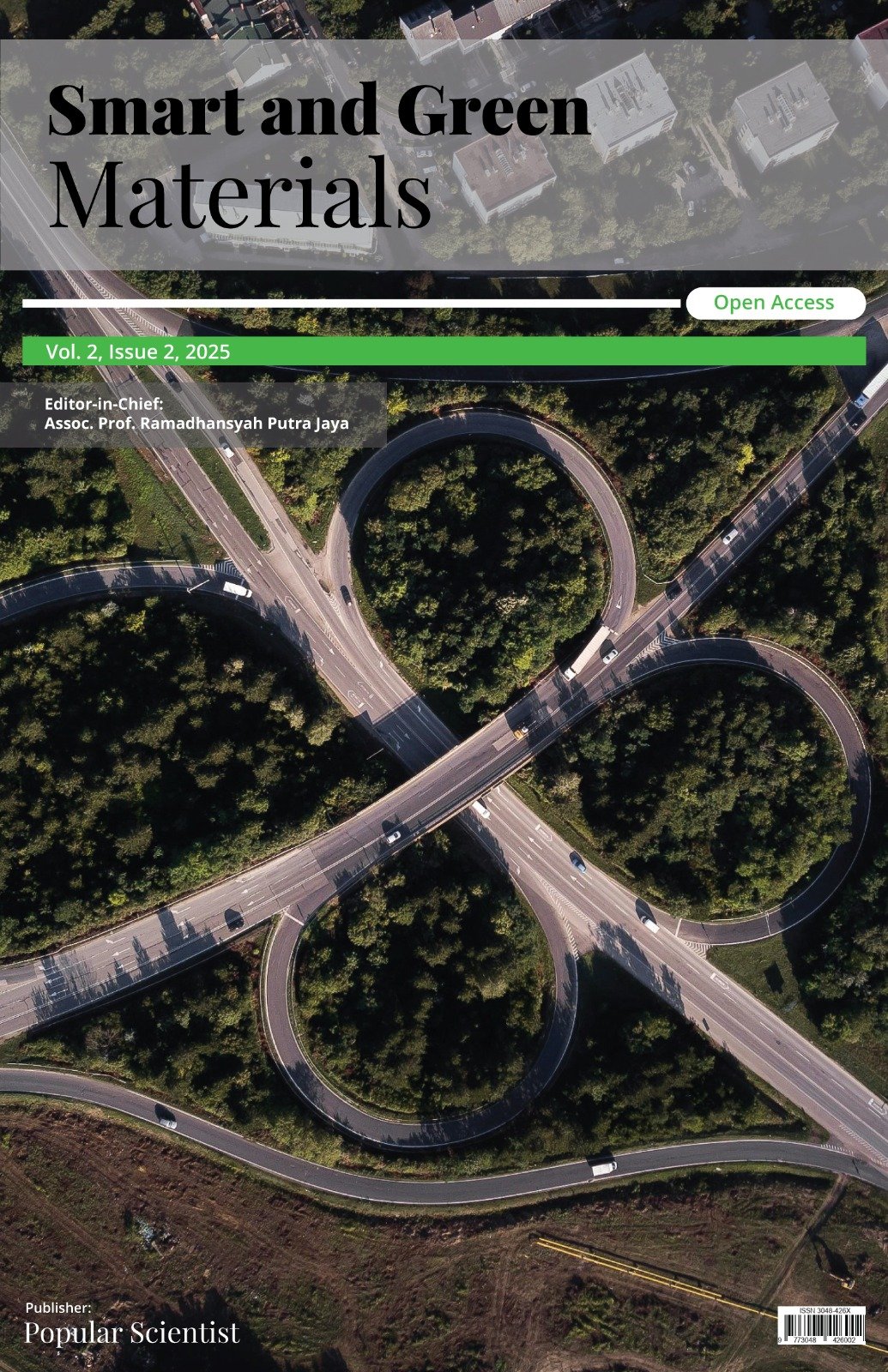Performance Assessment of Curing Techniques on Pozzolanic Concrete
DOI:
https://doi.org/10.70028/sgm.v2i2.43Keywords:
Pozzolanic, Concrete, Curing, Cement, StrengthAbstract
The strength development of Portland cement concrete primarily results from the formation of ettringite and calcium silicate hydrates during hydration, which requires sufficient moisture. Effective curing is essential to maintain the moisture needed for this reaction, significantly influencing compressive strength. As such, researchers continue to explore optimal curing methods. Additionally, the use of pozzolanic materials as partial replacements for ordinary Portland cement has gained interest, though their hydration and strength development are also affected by curing techniques. This study investigates the impact of four curing methods i.e. ponding, sprinkling, covering with an impermeable membrane, and chemical curing on the strength development of five pozzolanic concretes incorporating groundnut shell ash (GSA), coal bottom ash (CBA), locust bean pod ash (LBPA), wood ash (WA), and metakaolin. Sixty cylindrical specimens (150 mm × 300 mm) were prepared, with three samples per curing method for each pozzolan, tested at 3, 7, 14, and 28 days. The results show similar strength across all curing methods at 3 days. However, as curing continued, significant strength differences emerged. Chemical curing consistently produced the highest compressive strength due to its superior moisture retention, followed by ponding, membrane covering, and sprinkling. Regardless of pozzolan type, strength increased with extended curing periods. The study concludes that adequate curing time is vital for strength development in pozzolanic concretes. Among the methods evaluated, chemical curing is the most effective, followed by ponding and membrane methods, with sprinkling being the least effective. These findings offer practical guidance for selecting suitable curing techniques to optimize pozzolanic concrete performance under standard conditions.
Downloads
References
ASTM C33/C33M-18, Standard Specification for Concrete Aggregates. West Conshohocken, PA: ASTM International, 2018.
A. A. Raheem, A. A. Soyingbe, and A. J. Emenike, “Effect of curing methods on density and compressive strength of concrete,” Int. J. Appl. Sci. Technol., vol. 3, no. 4, pp. 55–64, 2013.
H. A. Toutanji and Z. Bayasi, “Effect of curing procedures on properties of silica fume concrete,” Cem. Concr. Res., vol. 29, pp. 497–501, 1999, doi: http://dx.doi.org/10.1016/S0008-8846(98)00197-5.
A. M. Neville, Properties of Concrete, 5th ed. London, U.K.: Pearson, 2010.
J. de-Prado-Gil et al., “A study on the prediction of compressive strength of self-compacting recycled aggregate concrete utilizing novel computational approaches,” Materials, vol. 15, no. 15, p. 5232, 2022, doi: http://dx.doi.org/10.3390/ma15155232.
O. Zaid et al., “To determine the performance of metakaolin-based fiber-reinforced geopolymer concrete with recycled aggregates,” Arch. Civ. Mech. Eng., vol. 22, no. 3, p. 114, 2022, doi: http://dx.doi.org/10.1007/s43452-022-00430-8.
M. K. D. Rout et al., “Feasibility study of reclaimed asphalt pavements (RAP) as recycled aggregates used in rigid pavement construction,” Materials, vol. 16, no. 4, p. 1504, 2023, doi: http://dx.doi.org/10.3390/ma16041504.
B. H. Z. Sami et al., “Feasibility analysis for predicting the compressive and tensile strength of concrete using machine learning algorithms,” Case Stud. Constr. Mater., vol. 18, p. e01893, 2023, doi: http://dx.doi.org/10.1016/j.cscm.2023.e01893.
BS 12:1996, Specification for Portland Cement. London, U.K.: British Standards Institution, 1996.
ASTM C618-78, Standard Specification for Pozzolanas. West Conshohocken, PA: ASTM International, 1978.
D. Meng et al., “Carbon sequestration and utilization in cement-based materials and potential impacts on durability of structural concrete,” Constr. Build. Mater., vol. 361, p. 129610, 2022, doi: http://dx.doi.org/10.1016/j.conbuildmat.2022.129610.
K. H. Khayat et al., “Rheological properties of ultra-high-performance concrete—An overview,” Cem. Concr. Res., vol. 124, p. 105828, 2019, doi: http://dx.doi.org/10.1016/j.cemconres.2019.105828.
P. Sikora et al., “Evaluating the effects of nanosilica on the material properties of lightweight and ultra-lightweight concrete using image-based approaches,” Constr. Build. Mater., vol. 264, p. 120241, 2020, doi: http://dx.doi.org/10.1016/j.conbuildmat.2020.120241.
R. Remya, P. Mattew, and K. Aboobacker, “Strength of concrete containing coal bottom ash,” Int. J. Res. Eng. Technol., vol. 3, no. 4, pp. 1–6, 2014.
C. Argiz, M. Á. Sanjuán, and E. Menéndez, “Coal bottom ash for Portland cement production,” Adv. Mater. Sci. Eng., vol. 2017, Art. no. 6068286, 2017, doi: http://dx.doi.org/10.1155/2017/6068286.
A. Y. Adama and Y. A. Jimoh, “Production and classification of locust bean pod ash (LBPA) as a pozzolan,” Civ. Eng. Portal, 2011. . Available: http://www.engineeringcivil.com/productionand-classification-of-locust-bean-pod-ash-lbpa-as-a-pozzolan.html.
E. A. Basha, R. Hashim, and A. S. Muntohar, “Effect of the cement-rice husk ash on the plasticity and compaction of soil,” Electron. J. Geotech. Eng., vol. 8, no. 1, pp. 1–10, 2003. Available: http://www.ejge.com/2003/Ppr0304/Ppr0304.zip.
A. S. Batt and A. Garg, “Partial replacement of wood ash with ordinary Portland cement and foundry sand as fine aggregate,” J. Civ. Environ. Eng., vol. 7, no. 3, pp. 1–8, 2017.
T. Bhavan, K. Madhu, and E. Syed, “Study on partial replacement of cement with metakaolin,” Int. J. Adv. Res. Innov., vol. 4, no. 2, pp. 45–52, 2016, doi: http://dx.doi.org/10.21474/IJAROI/2394.
BS EN 196-3:1995, Methods of Testing Cement—Part 3: Determination of Setting Time and Soundness. London, U.K.: British Standards Institution, 1995.
BS 812-103:1985, Testing Aggregates—Method for Determination of Particle Size Distribution. London, U.K.: British Standards Institution, 1985.
BS 812-112:1990, Testing Aggregates—Method for Determination of Aggregate Impact Value (AIV). London, U.K.: British Standards Institution, 1990.
ASTM C136-78, Standard Test Method for Sieve Analysis of Fine and Coarse Aggregates. West Conshohocken, PA: ASTM International, 1978.
BS 1881-102:1983, Testing Concrete—Method for Determination of Slump. London, U.K.: British Standards Institution, 1983.
BS EN 12350-2:2009, Testing Fresh Concrete—Part 2: Slump Test. London, U.K.: British Standards Institution, 2009.
BS 1881-116:1983, Testing Concrete—Method for Determination of Compressive Strength of Concrete Cubes. London, U.K.: British Standards Institution, 1983
Downloads
Published
Issue
Section
License
Copyright (c) 2025 Yaseer Adam Nabage, Aliyu Mani Umar, Bala Ismail Muhammad, Abdulkareem Abdulrahman (Author)

This work is licensed under a Creative Commons Attribution-NonCommercial 4.0 International License.













